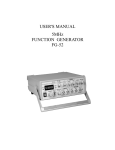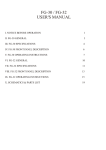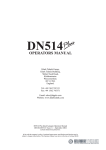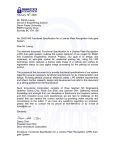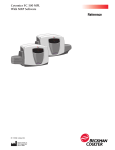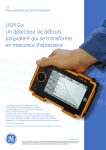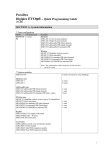Download Elenco Electronics GF-8056 User`s manual
Transcript
5MHz FUNCTION GENERATOR MODEL GF-8056 User’s Manual TM Elenco Electronics, Inc. TM Copyright © 2004 by Elenco Electronics, Inc. All rights reserved. No part of this book shall be reproduced by any means; electronic, photocopying, or otherwise without written permission from the publisher. 753117 NOTICE BEFORE OPERATION 1. Unpack the instrument: Hints for operating the instrument: Observe the following suggestions for successful instrument operation. After receiving the instrument, immediately unpack and inspect it for any damage which might have occured during transportation or shortage of accessories. If any signs of damage and/or shortage of accessories are found, notify the dealer immediately. 1. Never place heavy objects on the instrument. 2. Never place a hot soldering iron on or near the instrument. 3. Never insert wires, pins or other metal objects into the ventilation fan. 2. Environments: Normal operating temperature of the instrument is 10°C to 40°C (50°F to 104°F). Operation of the instrument outside of this temperature range may cause damage to the circuits. 4. Never move or pull the instrument with power cord or probe cord. Never move the instrument especially when the power cord or signal probe is connected to a circuit. Do not use the instrument in a place where strong magnetic or electric fields exist. Such fields may disturb the measurement. 5. If the instrument is used in a manner not specified by the manufacturer, the protection provided by the equipment may be impaired. 3. Check the Line Voltage: ! WARNING: The following precautions must The instrument can operate on any one of the line voltages shown in the table below by inserting the line voltage selector plug in the corresponding position on the rear panel. Before connecting the power plug to an AC line outlet, be sure to check that voltage selector plug is set in the correct position corresponding to the line voltage. be observed to help prevent electric shock. 1. When the instrument is used for testing, there is always a certain amount of danger from electrical shock. The person using the instrument should be a qualified electronics technician or otherwise trained and qualified to work in such circumstance. 2. Do not operate the instrument with the cover removed unless you are a qualified service technician. ! CAUTION: The instrument may not properly operate or may be damaged if it is connected to an AC line with the wrong voltage. When line voltages are changed, replacement of the fuses is also required. Selector Line Voltage Fuse 115V 100~125V 50/60Hz 600mA 230V 220~240V 50/60Hz 300mA 3. The ground wire of the 3-wire AC power plug places the chassis and housing of the instrument at earth ground. Use only a 3-wire outlet, and do not attempt to defeat the ground wire connection or float the instrument. Doing so may pose a great safety hazard. 4. Do not obstruct the ventilation holes in the rear panel, as this will increase the internal temperature. 5. Never apply an external voltage to the output BNC connector of the instrument. 6. Excessive voltage applied to the input BNC connector may damage the instrument. -1- GENERAL DESCRIPTION 3. As a Sweep Generator: The GF-8056 provides linear sweep or log sweep. Use the selection switch to select the sweep mode. Maximum sweep width 1:100 and sweep speed 5sec to 10ms. Also, the GF-8056 provides VCF input and synchronous output function. Easy-to-operate. The GF-8056 is a deluxe function generator combined with a 5-digit, high-resolution 60MHz counter. The GF-8056 is a rugged, easy-tooperate, excellent heat dissipating and high stability instrument. The GF-8056 is a 4-in-1 instrument. It can be used as the following described four kinds of electronic instruments respectively: 4. As a Counter: The GF-8056 is a 5-digit, micro-controlled counter. The GF-8056 features auto-range, autogate time and high-resolution - 0.001Hz, input impedance - 1MΩ, bandwidth - 0.2Hz~60MHz, voltage resistance - 150Vp-p. Other features the GF-8056 provides: adjustable trigger +2.5V with LED indication. Display unit auto-indicate, HF / LF selector, 100kHz filter. 1. As a Function Generator: Eight waveforms selected by a rotary switch instead of push-button to prevent accidental touching or bad connections. Maximum output 20Vp-p (no load) and minimum output 0.1Vp-p (no load). 2. As a Pulse Generator: 5. As a DC Voltage: The GF-8056 provides positive pulse and reverse negative pulse output with the Pull Reverse Switch, maximum output 20Vp-p (no load). Frequency display by the LED, pulse width from 0.4sec to 100ns. Can meet most audio, video and other basic electronic application requirements. The GF-8056 provides a DC output function. The output voltage can be adjusted from +10V to –10. It can be used as a low-power DC source. SPECIFICATIONS 1. General Specifications: C. Common Specification Operating temperature: 0°C~40°C, 10%~80% R.H. Storage temperature: –20°C~70°C, 0%~90% R.H. Power source: AC 115V (+10%) 50/60Hz, FUSE: 600mA AC 230V (+10%) 50/60Hz, FUSE: 300mA Power consumption: 25W Ventilation: DC 12V / 100mA fan Dimensions: 275 x 90 x 300mm Weight: 2.5 kgs. net. Accessory: Power cord, operation manual A. Generator Frequency: 0.05Hz~5MHz, display on 5-digit LED display, maximum resolution 0.001Hz in 8 ranges. Waveform output: Sine, square, triangle, positive, ramp, negative ramp, positive pulse and negative pulse, DC, 8 waveforms. Stability: 0.1%~15 minutes after switch “ON” 0.2%~24 hrs. after switch “ON” DC offset: +10V (no load), +5V (50Ω load), continuously adjustable, controlled by an offset switch. 2. Triangle Wave: B. Counter Frequency: 0.05Hz~5MHz Symmetry: 50% (rise wave) to 50% (fall wave), < 1%, 1Hz~100kHz Linearity: < 1%, (1Hz~100kHz) Display: 5 digits 0.36” red LED Max. resolution: 0.001Hz Display unit: Hz/kHz automatically controlled by CPU -2- SPECIFICATIONS (continued) 3. Sine Wave: 10. V.C.F. Input: Frequency: 0.05Hz~5MHz Input impedance: 0~10V Distortion: < 1%, 1Hz~100kHz Input frequency: DC~1kHz variable 1:1 to 1:100 Harmonic ratio: < 30dB, 100kHz~5MHz 11. Sweep Synchronous Output: Frequency response: < 0.1dB, up to 100kHz < 1.5dB, 100kHz to 5MHz Output impedance: 1kΩ, < 2% Output waveform: Linear or log sweep ramp wave 4. Square Wave: Frequency: 0.05Hz~5MHz Output amplitude: 10Vp-p (no load) or 5Vp-p (1kΩ load) Symmetry: 50% (positive half) to 50% (negative half). < 1%, 1Hz~100kHz Output frequency: 0.2Hz~100Hz continuously adjustable Rise time: < 90ns (20Vp-p , no load) 12. Sweep Generator: 5. Ramp Wave: Sweep form: Linear or log switchable Frequency: 0.05Hz~4.5MHz, 8 range selected by rotary switch Sweep speed: 5sec~10ms, continuously adjustable Symmetry: 90% (rise wave) to 10% (fall wave), continuously adjustable Sweep width: 1:1~1:100 13. Counter: Linearity: < 1%, (0.1Hz~100kHz) Display: 5 digits, 0.36” red LED display 6. Positive Pulse: Max. Resolution: 0.001Hz Frequency: 0.05Hz~4.5MHz Display unit: Hz / kHz autorange Width: 0.4sec~100ns, continuously adjustable Time base: 20MHz Symmetry: 1:1 to 10:1 continuously adjustable 1Hz~100kHz Temperature coefficient: < 20ppm / °C Reverse: Pull the Rev. switch, the output will become a negative pulse Power supply: +5V, 160mA Accuracy: <0.02% +1 digit Internal Counter: 7. DC: Range: Autorange with 4 resolution, 0.001Hz / 0.01Hz / 0.001kHz / 0.01kHz, auto-controlled by CPU Output voltage: +10V to –10V continuously adjustable by OFFSET switch Display: 0.500Hz~5000.0kHz auto-select by CPU 8. Main Output: Output impedance: 50Ω, < 2% Gate time: Variable, 0.25sec~5sec, auto-setting Max. output: 20Vp-p (no load), +1Vp-p 10Vp-p (50Ω load) +0.5V Min. display digits: 4 digits Min. output: 0.1Vp-p (no load), or 0.05Vp-p (50Ω load) External Counter: Max. input voltage: < 150Vrms Attenuator: One –26dB (1/20) attenuator, < 2% accuracy Input impedance: 1MΩ, < 2% Input frequency: 0.2Hz ~60MHz 9. Synchonous Output: Coupling: HF - 100kHz and greater LF - 100kHz and lower Output impedance: 50Ω, < 2% accuracy Output level: TTL level, > 3Vp-p fixed amplitude Min. display digits: 4 digits Fan out: >20 Gate time: Rise time: <60nS 0.25sec~10sec, auto-setting depends on the input frequency Sensitivity: > 30mVrms (1MHz) -3- FRONT PANEL DESCRIPTION 14 13 12 11 10 9 8 7 6 15 5 1 2 16 17 18 1. Power Switch: Pushing the switch “ON” will light the LED digits (14) to indicate power “ON”. 19 4 3 12. Hz: The lit LED indicates the display units are “Hz”. 13. kHz: The lit LED indicates the display units are “kHz”. 2. Frequency: Turn the switch to set the desired frequency generated. This knob is for micro-adjust. 14. LED Digits: 5 digits indicates the frequency generated or the EXT input. The units will be indicated by (12) or (13) selected by CPU automatically. 3. Synchronous Output: TTL level square wave signal. Output frequency as MAIN output. 15. EXT. Counter: The red LED indicates Ext. counter condition. LED lit - trigger level too high. LED dark - trigger level too low. LED flashing - triggering state. 4. Sweep Output: Sweep signal output BNC. It will operate individually whether the instrument set to sweep mode operation or not, output impedance of 1kΩ, output amplitude 10Vp-p, output signal: Linear or Log. 16. Display: Selects the source of the frequency displayed by (14). 5. Main Output: Waveform selected by Function switch. Max. output impedance 50Ω. Max. amplitude 20Vp-p (no load). INT Hz / kHz - Display the frequency of the signal generated by the GF-8056. 6. Amplitude: Turn switch to adjust the amplitude of the output signal. Pull out the switch to attenuate the output 20 times (or –26dB). EXT HF - Display the external input high frequency signal. This position filters out the DC signal and low frequency harmonic signal. Inputs only the expected high frequency signal. 7. DC Offset: The switch is set to OFF position in normal operation. When used for BIAS circuit, pull “ON” the switch and turn to adjust DC offset voltage. EXT LF - 100kHz Filter - Display the external input low frequency signal. Set to this position filters out the signal higher than 100kHz making the low frequency signal more stable. 8. Sweep Rate: Rotate switch to adjust the sweep rate from 5sec to 10mS at the Sweep Output (4). Pull switch to synchronous output signals from (4) and (5). 17. RAMP / PULSE: Rotate switch to generate a RAMP wave from a Triangle wave and a PULSE wave from a Square wave. Pull switch out to Invert position, output will be negative Ramp and negative Pulse. 9. Sweep Width: The switch is operational only when switch (8) is set to “ON”. Rotate the switch to adjust the sweep width. In the normal position (switch in), the unit is set to “Linear Sweep”. Pull the switch out for the “ON” position, set the unit to “Log Sweep”. 18. EXT Input: External signal input BNC. The input frequency is 0.2Hz to 60MHz, max. input voltage 150Vrms [when (17) is at “PULL” position]. 10. Function Wave Selector: Rotate switch to select between four output waveforms: sine, triangle, square, and DC. 19. V.C.F. Input: External input DC signal to control the frequency generated. External input AC sweep signal to make it external sweep. External input AC sine wave to make it external FM modulation. Input signal 0~10V, < 1kHz. Input impedance - 1kΩ. 11. Frequency Range: Selects output frequency range by rotating switch. The frequency displayed on (14) will be the product of the selected digits by (2) and (11). The frequency will be 10 times difference on each step. Four ranges: x1, x10, x100, x1000. -4- OPERATING INSTRUCTIONS WARNING: Before applying power to your GF-8056, make sure that the input voltage setting is correct for your power source. CAUTION: All the knobs are set to “PUSH” position on operation if not special marked to be set at “PULL”. (A) Function Generator and Inspection 4 5 7 6 1 3 2 6. Turn the AMPLITUDE knob to adjust the amplitude of the signal output to CH1. When you “PULL” out the switch, the amplitude will be reduced 20 times (–20dB), but the display of CH2 (sync output signal) will be unchanged. 1. Turn on the power switch and make sure the LED’s of the 5-digit display light. 2. Connect MAIN OUTPUT BNC of the GF-8056 to CH1 input BNC of your Oscilloscope, and the SYNC OUTPUT BNC to CH2. Set the trigger source of your oscilloscope to CH2. 7. Turn the OFFSET knob. You will find that CH1 and CH2 will not change. This switch will operate only in the “PULL” position. PULL out the offset switch and turn it to set DC offset voltage (from +10V to –10V) of the main output signal. Note that the SYNC output signal will be not affected. 3. Turn the FREQUENCY knob from x0.05~x5.0 The GF-8056 display and oscilloscope will be changed slightly on each step. 4. Turn the RANGE knob from x1~x1000. You will find the 5-digit LED display value will change 10 times on each step and the oscilloscope too. When the switch (7) is set at Hz or kHz, the display value will be changed to x1 or x1000. Note: When the offset voltage is higher than the wave (+ or –), the display waveform will be cut OFF. 5. Turn the FUNCTION knob to select the waveform output to CH1 of your Oscilloscope. CH2 will be TTL square wave only. -5- (B) Sweep Generator 7 6 5 4 6 1 8 3 2 1. Turn on the power switch and make sure the LED’s of the 5-digit display light. 6. The AMPLITUDE and FUNCTION knobs will operate as a generator. 2. Connect the main OUTPUT BNC to the CH1 input BNC of your oscilloscope. 7. The frequency shown on the 5-digit LED display is the generator’s before “PULL SWEEP ON”. This frequency will be the start frequency. After “PULL SWEEP ON”, the sweep condition, including frequency, waveform, sweep mode, etc., will be observed from the CRT of the oscilloscope. The 5-digit LED display will continuously vary. 3. Connect the SWEEP OUTPUT BNC to the CH2 input BNC of your oscilloscope and set the trigger source of the oscilloscope at CH2. 4. Turn the SWEEP RATE knob. CH2 of the oscilloscope will display a linear sawtooth wave and the frequency will be variable from 5sec to 10mS by turning the switch. CH1 will display the wave according to the FUNCTION switch position. PULL out the switch to set “SWEEP ON”. The display of CH2 will be unchanged and the display frequency will be varied by turning the knobs. Note that the display of CH1 will be a sweep wave, and the speed will depend on the sweep rate. 8. V.C.F. INPUT - Set the sweep rate switch at the “PUSH” position to set the GF-8056 at normal generator mode. Connect the sweep output BNC to V.C.F. INPUT BNC and check the waveform displayed on CH1 of the scope. The waveform displayed should be the sweep wave. When inputting a sine wave from another generator to the V.C.F. INPUT to observe the FM display, be sure the frequency of the basic wave (GF-8056) is higher than the external input signal. NOTE: After “PULL SWEEP ON”, the trigger source of the oscilloscope must be changed from CH2 to CH1. 5. Turn the SWEEP WIDTH knob to adjust the sweep width display on CH1. NOTE: Be sure that the SWEEP RATE SWITCH was at the “PULL” position. When pulling out the sweep width switch, the sweep mode will change from linear to log sweep. The waveform display of CH1 will become log form. -6- (C) Pulse Wave Generator 5 4 9 8 1 6 3 1. Turn on the power switch and make sure the LED’s of the 5-digit display light. 2 6. Set the pulse width by adjusting the knob (6). 7. Pull the knob (6) to display the negative pulse position. 2. Connect the MAIN OUTPUT BNC to CH1. 3. Connect the SYNC OUTPUT BNC to CH2 and set the trigger source of the oscilloscope on CH2. 8. Turn the AMPLITUDE knob to adjust the amplitude of the signal output from the main output BNC (2). The signal will be –26dB when you “PULL” out the switch. But the signal output from the “SYNC” output BNC (3) will not be affected by this switch. The output signal of the “SYNC” output will keep at a TTL level. 4. Set the FUNCTION knob to the square wave position ( ) and turn the knob (6) until the display becomes the pulse waveform you want. 5. Set the FREQUENCY and RANGE to the desired frequency. 9. Set the DC offset voltage by pulling out the “OFFSET” switch. Turn switch to adjust the DC offset voltage from +10V to –10V. -7- (D) Frequency Counter 2 3 1 4 3 1. Turn on the power switch and make sure the LED’s of the 5-digit display light. 3. Connect the EXT INPUT BNC to the external signal source, the EXT LED lights. 2. DISPLAY: The coupling provides 4 steps. 4. Display unit: The display unit of the GF-8056 will be on Hz or kHz automatically controlled by CPU. (a). INT/Hz: To use the internal counter from 0.05Hz to 5kHz. (b). INT/kHz: To use the internal counter from 0.5kHz to 5MHz. (c). EXT HF: To use the external counter for high frequency (100kHz to 60MHz). (d). EXT LF: To use the external counter for low frequency (0.2Hz to 100kHz). -8- -9- -10- TM Elenco Electronics, Inc. 150 W. Carpenter Avenue Wheeling, IL 60090 (847) 541-3800 Website: www.elenco.com e-mail: [email protected]












